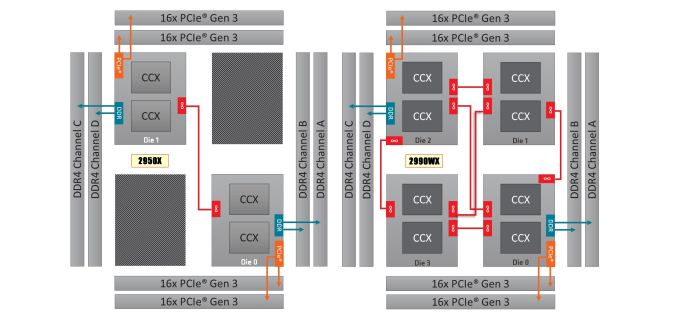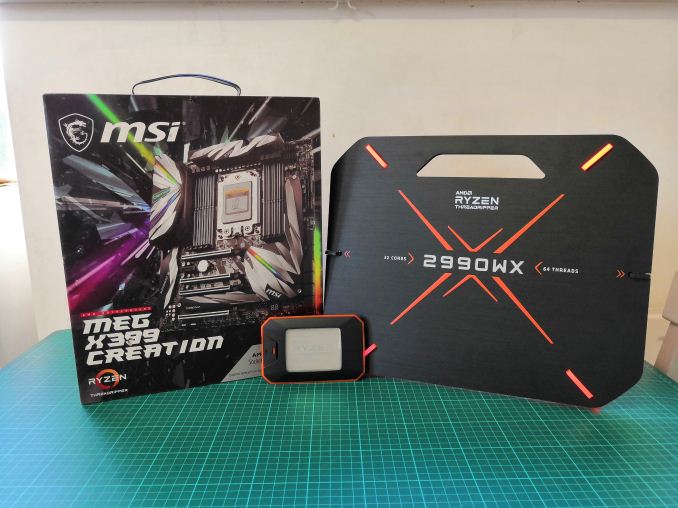The AMD Threadripper 2990WX 32-Core and 2950X 16-Core Review
by Dr. Ian Cutress on August 13, 2018 9:00 AM ESTConclusions: Not All Cores Are Made Equal
Designing a processor is often a finely tuned craft. To get performance, the architect needs to balance compute with throughput and at all times have sufficient data in place to feed the beast. If the beast is left idle, it sits there and consumes power, while not doing any work. Getting the right combination of resources is a complex task, and the reason why top CPU companies hire thousands of engineers to get it to work right. As long as the top of the design is in place, the rest should follow.
Sometimes, more esoteric products fall out of the stack. The new generation of AMD Ryzen Threadripper processors are just that – a little esoteric. The direct replacements for the previous generation units, replacing like for like but with better latency and more frequency, are a known component at this point and we get the expected uplift. It is just this extra enabled silicon in the 2990WX, without direct access to memory, is throwing a spanner in the works.
2950X (left) and 2990WX (right)
When some cores are directly connected to memory, such as the 2950X, all of the cores are considered equal enough that distributing a workload is a fairly easy task. With the new processors, we have the situation on the right, where only some cores are directly attached to memory, and others are not. In order to go from one of these cores to main memory, it requires an extra hop, which adds latency. When all the cores are requesting access, this causes congestion.
In order to take the full advantage of this setup, the workload has to be memory light. In workloads such as particle movement, ray-tracing, scene rendering, and decompression, having all 32-cores shine a light means that we set new records in these benchmarks.
In true Janus style, for other workloads that are historically scale with cores, such as physics, transcoding, and compression, the bi-modal core caused significant performance regression. Ultimately, there seems to be almost no middle ground here – either the workload scales well, or it sits towards the back of our high-end testing pack.
Part of the problem relates to how power is distributed with these big core designs. As shown on page four, the more chiplets that are in play, or the bigger the mesh, the more power gets diverted from the cores to the internal networking, such as the uncore or Infinity Fabric. Comparing the one IF link in the 2950X to the six links in 2990WX, we saw the IF consuming 60-73% of the chip power total at small workloads, and 25-40% at high levels.
In essence, at full load, a chip like the 2990WX is only using 60% of its power budget for CPU frequency. In our EPYC 7601, because of the additional memory links, the cores were only consuming 50% of the power budget at load. Rest assured, once AMD and Intel have finished fighting over cores, the next target on their list will be this interconnect.
But the knock on effect of not using all the power for the cores, as well as having a bi-modal operation of cores, is that some workloads will not scale: or in some cases regress.
The Big Cheese: AMD’s 32-Core Behemoth
There is no doubting that when the AMD Ryzen Threadripper 2990WX gets a change to work its legs, it will do so with gusto. We were able to overclock the system to 4.0 GHz on all cores by simply changing the BIOS settings, although AMD also supports features like Precision Boost Overdrive in Windows to get more out of the chip. That being said, the power consumption when using half of the cores at 4.0 GHz pushes up to 260W, leaving a full loaded CPU nudging 450-500W and spiking at over 600W. Users will need to make sure that their motherboard and power supply are up to the task.
This is the point where I mention if we would recommend AMD’s new launches. The 2950X slots right in to where the 1950X used to be, and at a lower price point, and we are very comfortable with that. However the 2950X already sits as a niche proposition for high performance – the 2990WX takes that ball and runs with it, making it a niche of a niche. To be honest, it doesn’t offer enough cases where performance excels as one would expect – it makes perfect sense for a narrow set of workloads where it toasts the competition. It even outperforms almost all the other processors in our compile test. However there is one processor that did beat it: the 2950X.
For most users, the 2950X is enough. For the select few, the 2990WX will be out of this world.












171 Comments
View All Comments
jospoortvliet - Saturday, August 18, 2018 - link
https://www.phoronix.com/scan.php?page=article&... has some.nul0b - Monday, August 13, 2018 - link
Ian please define how exactly you're calculating and deriving uncore and IF power utilization.alpha754293 - Monday, August 13, 2018 - link
I vote that from now on, all of the CPU reviews should be like this.Just raw data.
Lolimaster - Monday, August 13, 2018 - link
To resume:Intel's TDP is a blatant lie, it barely keeps at TDP at 6c/6t, meanwhile AMD stick on point or below TDP with their chips, boost included :D
Lolimaster - Monday, August 13, 2018 - link
Selling more shares from $1.65 now to $19 :DAMD Threadripper 2, ripping the blue hole.
Lolimaster - Monday, August 13, 2018 - link
It seems geekbench can't scale beyond 16cores.Lolimaster - Monday, August 13, 2018 - link
WHERE IS CINEBENCH?Lolimaster - Monday, August 13, 2018 - link
And I mean CB15Also, for some reason CB11.5 MT seems to be broken for TR, it stops caling at 12cores.
mapesdhs - Monday, August 13, 2018 - link
CB R15 is suffering issues aswell these days, at this level it can exhibit huge variance from one run to another.eastcoast_pete - Monday, August 13, 2018 - link
Thanks Ian, great article, look forward to seeing the full final version!My conclusions: All these are workstation processors, NOT for gaming; the Ryzen 2700X and the upcoming Intel octacore 9000 series are/will be better for gaming, both in value for money and absolute performance. That being said, the TR 2950X could be a great choice, if your productivity software can make good use of the 16 cores/32 threads, and if that same software isn't written to make strong use of AVX 512. If the applications that you buy these monsters can make heavy use of AVX 512, Intel's chips are currently hard or impossible to beat, even at the same price point. That being said, a 2950X workstation with 128 or 256 Gb of RAM (in quad channel, of course), plus some fast PCIe/NVMe SSDs and a big & fast graphics card would make an awesome video editing setup; and, the 60 PCIe channels would come in really handy for add-in boards. One fly in the ointment: AMD, since you're hamstringing TR with only quad-channel, at least let us use faster DDR4; how about officially supporting > 3.2 Ghz?
Unrelated: Love the testing setup where the system storage SSD ( 1TB) is the same size as the working memory (1 TB). With one of these, you know you're in the heavyweight division.
@Ian: I also really appreciate the testing of power draws by cores vs. interconnecting fabric. I also believe (as you wrote) that this is a much underappreciated hurdle in simply escalating the number of cores. I also wonder a. How is that affecting ARM-based multicore chips, especially once we are talking 32 cores and up, as for the chips intended for servers? and b. Is that one of the reasons (or THE reason) why ARM-based manycore solutions have not been getting much traction, and why companies like Qualcomm have stopped their development? Yes, the cores might be very efficient, but if those power savings are being gobbled up by the interconnects, fewer but broader and deeper cores might still end up winning the performance/wh race.
If you and/or Ryan (or any of your colleagues) could do a deep dive into the general issue of power use by the interconnecting fabric and the different architectures, I would really appreciate it.